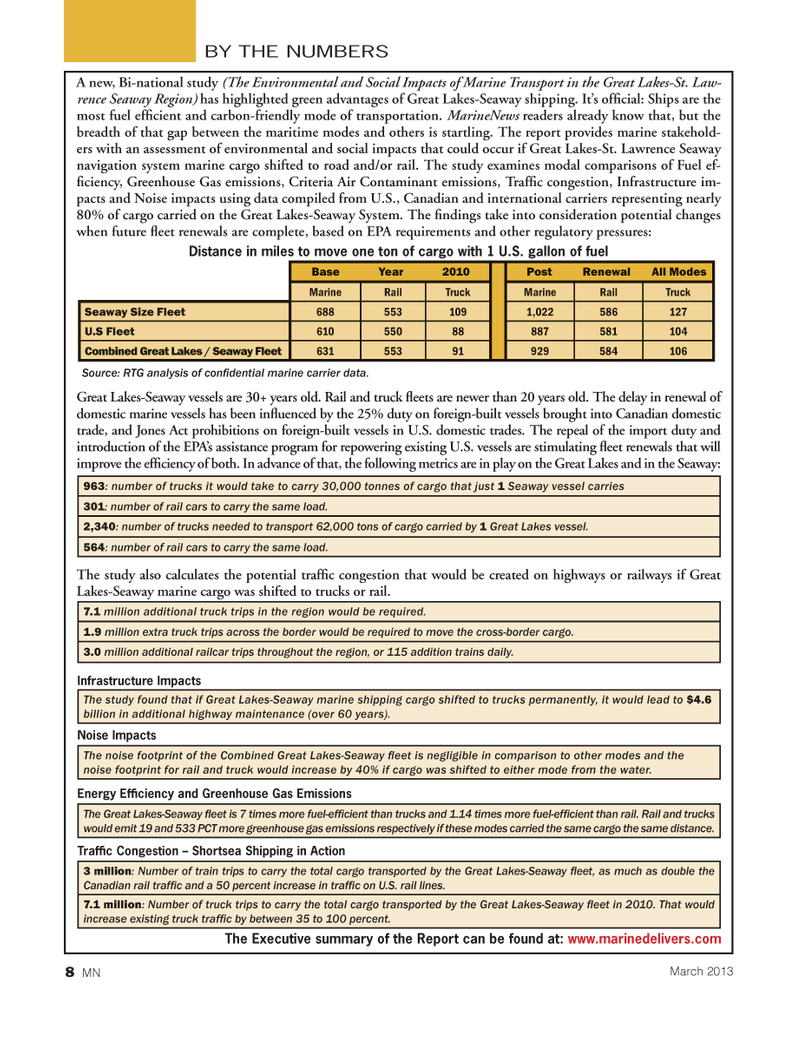
Page 8: of Marine News Magazine (March 2013)
Shipyard Report: Construction & Repair
Read this page in Pdf, Flash or Html5 edition of March 2013 Marine News Magazine
A new, Bi-national study (The Environmental and Social Impacts of Marine Transport in the Great Lakes-St. Law- rence Seaway Region) has highlighted green advantages of Great Lakes-Seaway shipping. It?s of cial: Ships are the most fuel ef cient and carbon-friendly mode of transportation. MarineNews readers already know that, but the breadth of that gap between the maritime modes and others is startling. The report provides marine stakehold- ers with an assessment of environmental and social impacts that could occur if Great Lakes-St. Lawrence Seaway navigation system marine cargo shifted to road and/or rail. The study examines modal comparisons of Fuel ef- ciency, Greenhouse Gas emissions, Criteria Air Contaminant emissions, Traf c congestion, Infrastructure im- pacts and Noise impacts using data compiled from U.S., Canadian and international carriers representing nearly 80% of cargo carried on the Great Lakes-Seaway System. The ndings take into consideration potential changes when future eet renewals are complete, based on EPA requirements and other regulatory pressures: Great Lakes-Seaway vessels are 30+ years old. Rail and truck eets are newer than 20 years old. The delay in renewal of domestic marine vessels has been in uenced by the 25% duty on foreign-built vessels brought into Canadian domestic trade, and Jones Act prohibitions on foreign-built vessels in U.S. domestic trades. The repeal of the import duty and introduction of the EPA?s assistance program for repowering existing U.S. vessels are stimulating eet renewals that will improve the ef ciency of both. In advance of that, the following metrics are in play on the Great Lakes and in the Seaway: The study also calculates the potential traf c congestion that would be created on highways or railways if Great Lakes-Seaway marine cargo was shifted to trucks or rail. Base Year 2010 Post Renewal All Modes MarineRailTruckMarineRailTruck Seaway Size Fleet 6885531091,022586127 U.S Fleet61055088887581104 Combined Great Lakes / Seaway Fleet 63155391929584106 963: number of trucks it would take to carry 30,000 tonnes of cargo that just 1 Seaway vessel carries 301 : number of rail cars to carry the same load. 2,340: number of trucks needed to transport 62,000 tons of cargo carried by 1 Great Lakes vessel. 564: number of rail cars to carry the same load. 7.1 million additional truck trips in the region would be required. 1.9 million extra truck trips across the border would be required to move the cross-border cargo. 3.0 million additional railcar trips throughout the region, or 115 addition trains daily. The study found that if Great Lakes-Seaway marine shipping cargo shifted to trucks permanently, it would lead to $4.6 billion in additional highway maintenance (over 60 years). The noise footprint of the Combined Great Lakes-Seaway ß eet is negligible in comparison to other modes and the noise footprint for rail and truck would increase by 40% if cargo was shifted to either mode from the water. The Great Lakes-Seaway ß eet is 7 times more fuel-ef Þ cient than trucks and 1.14 times more fuel-ef Þ cient than rail. Rail and trucks would emit 19 and 533 PCT more greenhouse gas emissions respectively if these modes carried the same cargo the same distance. 3 million: Number of train trips to carry the total cargo transported by the Great Lakes-Seaway ß eet, as much as double the Canadian rail traf Þ c and a 50 percent increase in traf Þ c on U.S. rail lines. 7.1 million : Number of truck trips to carry the total cargo transported by the Great Lakes-Seaway ß eet in 2010. That would increase existing truck traf Þ c by between 35 to 100 percent. BY THE NUMBERSDistance in miles to move one ton of cargo with 1 U.S. gallon of fuel Infrastructure Impacts Noise Impacts Energy EfÞ ciency and Greenhouse Gas Emissions TrafÞ c Congestion Ð Shortsea Shipping in Action Source: RTG analysis of conÞ dential marine carrier data. The Executive summary of the Report can be found at: www.marinedelivers.com 8 MNMarch 2013 MN March2013 Layout 1-17.indd 8MN March2013 Layout 1-17.indd 83/5/2013 9:37:18 AM3/5/2013 9:37:18 AM

 7
7

 9
9
